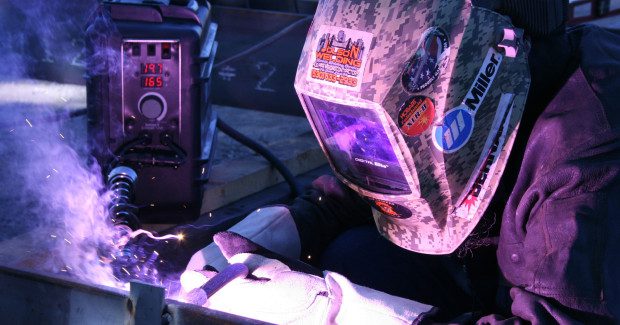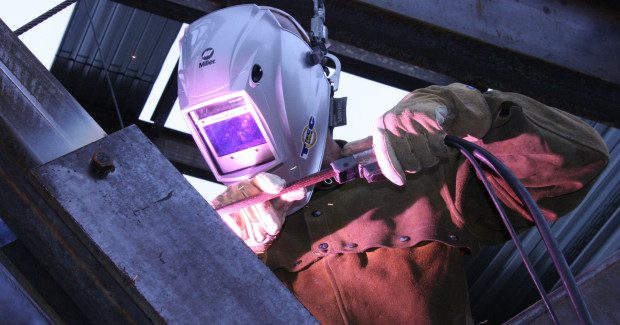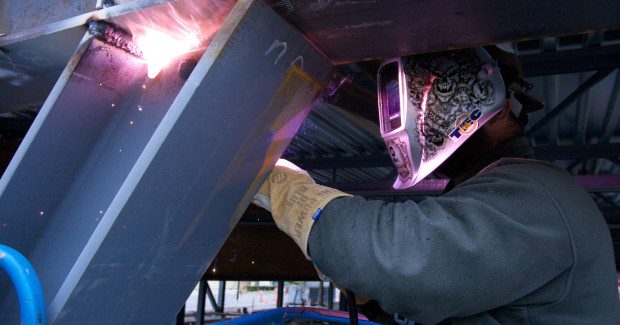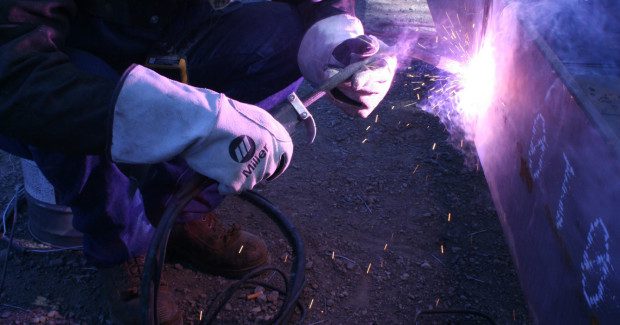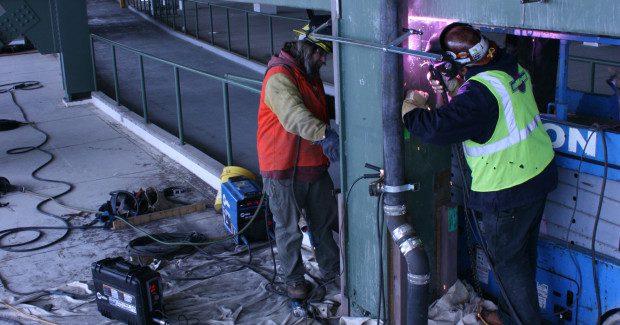Overcoming Barriers That Prevent Using Wire Welding in the Field
Not every welding application on a jobsite can be transitioned over to wire, but noticeable productivity and quality gains can result from switching some of them to wire processes.
Posted: August 26, 2014
Many factors come into play when choosing the appropriate welding process for the jobsite: the application, position of the weld, material type, welding procedure and possible job or contract requirements.
Wire welding processes offer significant benefits that make them a frequent choice for welding jobs in the fabrication shop, including high weld quality, along with increased productivity and efficiency by way of travel speeds that are three to four times those of TIG or Stick welding. The same benefits can be realized with many welding jobs in the field.
Much of the return on investment in wire processes comes from increased productivity. Because most of the costs associated with welding in the field are related to labor — approximately 80 percent — giving welding operators advanced technology and equipment helps improve their productivity and safety, while saving significant time and money in the long run.
Traditionally, many companies have used TIG and Stick welding in the field, in part due to the familiarity with the processes and also because of some of the challenges their welding operators may have encountered using wire welding — MIG and Flux-Cored — in these applications. These challenges can range from issues with burnback and bird-nesting to premature consumable failure, but the good news is that they can be easily remedied with a little equipment and technique know-how.
Following a few guidelines for appropriate usage and implementing the solutions discussed in this article can help ensure success when using MIG and Flux-Cored welding in the field, so companies can reap the productivity, efficiency and quality benefits the processes offer.
SELECTING THE RIGHT CONSUMABLES AND EQUIPMENT
The formula for success when using wire processes in the field starts with choosing the right equipment and consumables for the job. These include the appropriate style and size of wire, drive roll, gun and cable liner.
Drive Rolls
Knowing what kind of drive roll to select and how to set proper tension can help prevent many problems associated with wire feeding. Design enhancements from some manufacturers, such as improved drive roll systems, also are helping address common drive roll issues.
When selecting the size and type of drive roll, consider the size and type of wire being used for the application. Since flux-cored wire is softer (due to the flux inside and the tubular design), it requires a knurled drive roll, which has teeth to grab the wire and help push it through. However, knurled drive rolls should not be used with solid wire because the teeth will cause shavings to break off of the wire. Those shavings can clog the liner and wear out the front-end consumables faster. Use a smooth, V-groove drive roll with solid wire to avoid this problem.
Setting proper drive roll tension is essential. Drive rolls are designed to feed the wire smoothly from the wire spool into the gun cable. Setting the drive roll tension too tight can deform the wire, which can result in arc instability or burnback. Too little tension also can be problematic and cause wire slippage. To set the proper tension, begin by releasing the tension on the drive rolls. The welding operator can increase the tension while feeding the wire into the palm of his or her welding glove, continuing to increase the tension one half-turn past wire slippage.
Most feeders now come installed with an inlet guide, which helps guide the wire into the drive roll properly. Inlet guides are designed to work with a range of wire sizes, so make sure the inlet guide being used is properly sized for the wire, as well.
Gun Liners
Having the proper gun liner and maintaining it is important to preventing arc and wire feeding problems. Arc instability and burnback can result fromliners that are kinked, worn, the wrong size or partially plugged. Welding operators can blow compressed air through the liners as a way to remove dirt and debris, and improve feeding performance. Keeping the welding wire clean and changing out the liners as necessary is also important to avoiding clogs.
Common causes of bird-nesting — a tangle of wire in the drive rolls — include blockages of the liner, improperly trimmed liners and using the wrong liner. Promptly replace the liner if a blockage is found during routine inspection of the welding gun and cables, and always trim the liner according to the manufacturer’s recommendation. Keep the liner free of any burrs or sharp edges, and always use the correct size liner to match the diameter of the welding wire.
Wire Selection
Wire feeding issues also can affect performance, since good welds require a constant wire feed supply. Make sure to select the correct wire type for the welding procedure, and make sure the wire is feeding properly. One way to test if the wire is feeding smoothly is to feed the wire against a block of wood and watch for the wire to continuously coil up smoothly, which implies there is no obstruction to the wire feed. If the wire does not coil smoothly, there is a problem somewhere in the wire feed process that needs to be addressed accordingly.
Gun Selection
The amperage needed for the application dictates how to choose a gun for welding in the field. Many of the welds performed in field applications are performed out-of-position, such as vertical or overhead. To prevent the weld pool from becoming too large and too fluid to control in these situations, lower wire feed speeds and corresponding lower amperages are used. Typically, a 300-amp gun will be enough to handle many jobs using MIG and Gas-Shielded Flux-Cored welding in the field.
It’s important, however, to select a gun that has enough amperage for the job. Running a gun beyond its amperage range will quickly damage it from overheating. Conversely, lack of fusion (cold lap) and defective welds can be problems when welding with too little heat (e.g. a gun with too-low amperage).
Contact Tip Selection
Contact tip issues can cause arc instability, wire stubbing and burnback. To help avoid these problems, match the contact tip size with the wire size being used, and replace the contact tip when the exit hole becomes worn or oblong with use. Worn contact tips result in irregular feeding and difficulty keeping the wire positioned in the weld pool.
Shielding Gas and Nozzle Selection
The shielding gas protects the molten weld pool from the surrounding atmosphere, which would otherwise contaminate the weld. Using the wrong type of shielding gas for the application can cause problems. The proper gas for the job is based on the filler metal being used, the material being welded, and sometimes the welding process. When welding steel, a 75 percent argon/25 percent carbon dioxide mixture is typically recommended to minimize spatter and provide good penetration. Reference the weld procedure materials for guidelines on choosing the proper gas.
Nozzle design and cleanliness are very important. Using a quality gas diffuser and a larger diameter nozzle helps ensure adequate shielding gas coverage of the weld. Choosing a smaller-diameter gas nozzle will help to maintain the proper wire stick-out when reaching into deep groove welds. Also, make sure to keep nozzles clean, as they can become filled with spatter, which can lead to lack of shielding gas coverage.
FEEDER OPTIONS
Welding operators may question whether the equipment needed for wire processes is durable enough for the field environment. In fact, manufacturers offer suitcase feeders constructed from impact-resistant and flame-resistant plastics, which can withstand the abuse typically encountered in field applications.
A demonstration of the a Miller SuitCase® wire feeder for MIG and Flux Cored welding in the field.
Two types of feeders are available, and the choice between the two is based on the diameter of the wire spool. Highly portable suitcase feeders designed for 8-inch wire spools are lighter and can be a good fit for applications where space or access are limited. A larger version of the suitcase feeder will handle 12-inch spools, which is beneficial when arc-on time is high, because the welding operator won’t have to change the spool as often. Typical suitcase feeders weigh about 25 pounds, with the total weight dependent upon the selection of the filler metal and wire spool packaging.
The next decision about wire feeders is to select between a voltage sensing model and a feeder with remote voltage control. Voltage sensing feeders often are used for field construction because they require only a weld cable, minimizing the need to transport additional cables to the jobsite, as well as reducing clutter and maintenance requirements. However, this type of feeder necessitates going to the power source each time voltage needs to be adjusted. Conversely, wire feeders equipped with remote voltage control traditionally require a control cable from the feeder to the power source. This feature adds to the task of cable stringing, cost and maintenance of the cable, but reduces trips to the power source. One technology advancement makes it possible to have the benefits of both types of feeders, since it communicates over the weld cable to set the voltage at the feeder, thereby eliminating the need for a control cable, reducing jobsite clutter and improving safety for workers.
As technology migrates from the traditional bench-style feeders used in fabrication shops to the portable suitcase feeders used in the field, quality improves in field applications.
SOLVING THE PROBLEM OF POROSITY
Porosity in the weld is a common concern raised by welding operators regarding wire processes in the field. This problem can stem from using the wrong type of gas, having too much or too little gas flow, or dirt or rust on the material being welded. Porosity is typically caused by a wire/gas combination issue or a gas delivery issue.
Because lack of shielding gas can cause porosity in the weld bead, check that there are no gas flow problems in the MIG gun, such as a tear or hole in the gas hose, and that the MIG gun O-rings are in good condition.
Also check to make sure the gas valve is turned on, that the cylinder has gas and that the appropriate flow rate has been set. It’s important to have a consistent flow rate of about 30 to 35 cubic feet per minute. If the gas flow is turned up too high, it can create turbulence in the weld pool. Flow gauges are available that tell operators the flow rate of the gas.
DEALING WITH WIND
Wind is an issue that may come into play when using gas-shielded wire processes in outdoor applications. Similar to TIG welding, which is commonly used for root pass welds in the field, wire processes (with the exception of Self-Shielded Flux-Cored welding) require shelter to protect the shielding gas from being disrupted or blown away.
In many cases, huts are constructed to block the wind and protect the weld from the weather. Portable fabrication facilities are constructed on some jobsites to provide a controlled environment for welding, which helps improve quality and productivity.
OTHER TROUBLESHOOTING TIPS TO REMEMBER
There are different types of transfer modes available in MIG welding, so it’s important to be aware of the variances and how suitable each type is for use with specific materials. The transfer modes are: short-circuit transfer, globular transfer, spray transfer and pulsed spray transfer.
Proper filler metal storage and careful MIG gun usage are also essential to gain good welding performance.
For the best results, store filler metals in a clean and dry area to help prevent exposure to moisture in the air or environment, and with it, issues of hydrogen pickup, which can lead to weld cracking. Follow the storage recommendations from the manufacturer for the classification of wire being used.
Also, avoid coiling the gun while welding, which can cause wire-feeding restrictions. Laying the cables flat on the ground is preferred, when possible.
If the application dictates the use of anti-spatter, use it sparingly. Overuse of such substances can lead to weld quality issues.
TAKE PROACTIVE MEASURES TO ENSURE SUCCESS WITH WIRE
Just as the proper equipment and consumables are key to successfully using wire processes in the field, providing training and resources for welding operators is another important step that can help improve success.
For welding operators trained only on Stick and TIG welding, some training is necessary on the use of MIG and Flux-Cored processes, as well as on identifying potential problems with wire welding and on fixing the issues quickly. It’s also important to have a wire welding expert on the jobsite who can help troubleshoot problems and answer questions that may arise. Once a welding operator is trained in wire processes, the welds often are easier to complete; and advanced wire processes, such as Pulsed MIG and Modified Short Circuit Transfer — available in welding machines designed for field use — can further shorten the training time due to their ease of use, making it easier to train a welder to produce x-ray quality welds in less time.
Using wire processes in field applications can result in greater output in the long run, and following best practices and proper equipment selection can help companies get there sooner. Not every welding application on a jobsite can be transitioned over to wire, but noticeable productivity and quality gains can result from switching some of the applications to wire processes.
This additional tool in the toolbox can result in improved quality and efficiency and greater output. The bottom line is that with attention to the specific challenges of wire welding in field applications, welding operators can see the tradeoffs of higher productivity and efficiency, as well as increased quality.





